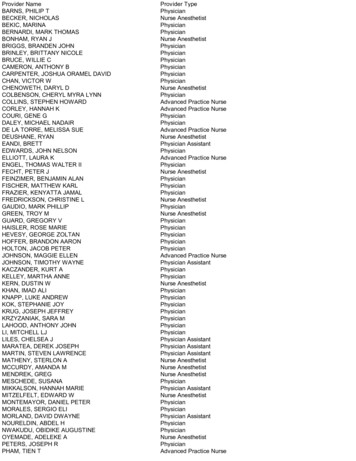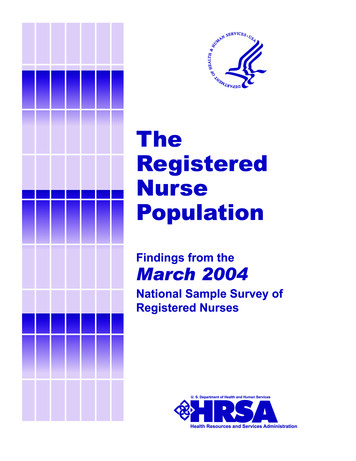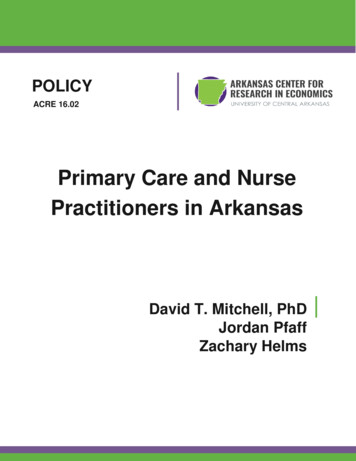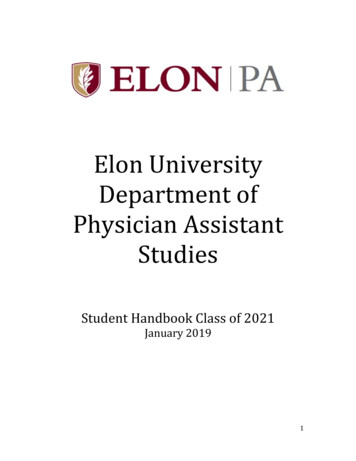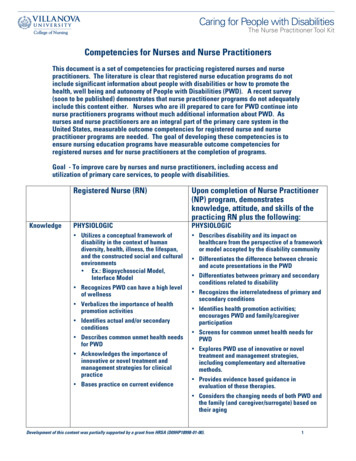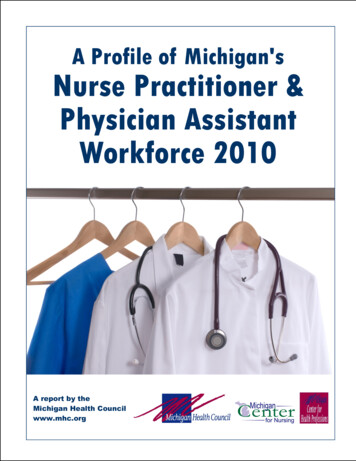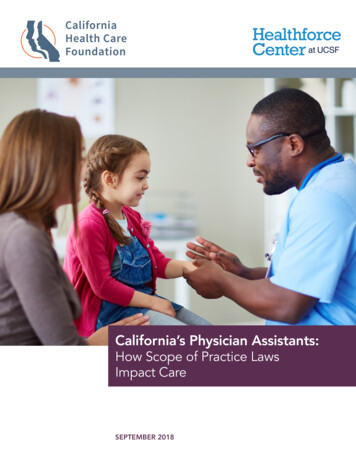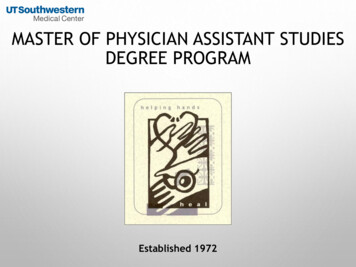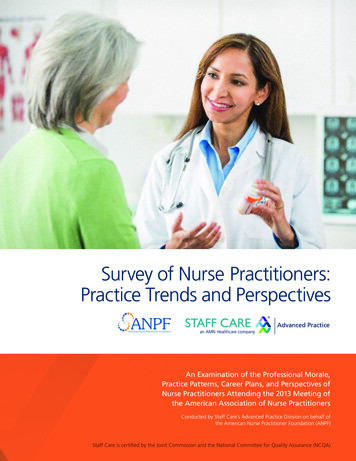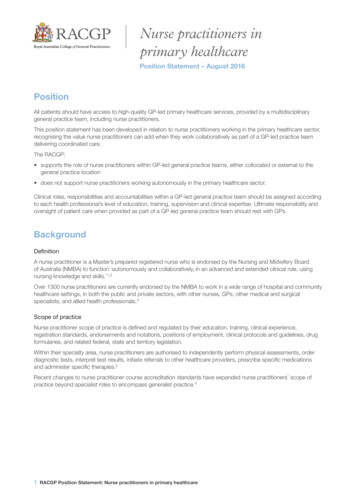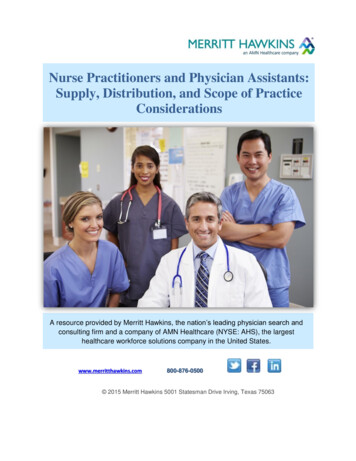
Transcription
Nurse Practitioners and Physician Assistants:Supply, Distribution, and Scope of PracticeConsiderationsA resource provided by Merritt Hawkins, the nation’s leading physician search andconsulting firm and a company of AMN Healthcare (NYSE: AHS), the largesthealthcare workforce solutions company in the United States.www.merritthawkins.com800-876-0500 2015 Merritt Hawkins 5001 Statesman Drive Irving, Texas 75063
NURSE PRACTITIONERS AND PHYSICIAN ASSISTANTS:SUPPLY, DISTRIBUTION, AND SCOPE OF PRACTICE CONSIDERATIONSA resource provided by Merritt Hawkins, the nation’s leading physician search andconsulting firm and a company of AMN HealthcareIntroductionMany (though not all) healthcare policy analysts agree that the United States is in the midst of awidespread and growing physician shortage. The dearth of doctors has placed a growing premium onadvanced practitioners, including nurse practitioners (NPs) and physician assistants (PAs) who canperform many of the duties performed by physicians.NPs and PAs also fit the concept of team-based care, in which a variety of clinicians work in a coordinatedmanner, performing tasks appropriate to their training on behalf of patients.Estimates suggest that primary care physicians taking sole responsibility for the care of their patientswould need to spend 18 hours per day to provide a full range of diagnostic and preventive services,supporting the implementation of the team-based model of care (Transforming Primary Care: From PastPractice To the Practice of the Future.” Health Affairs).Additional factors driving the use of NPs and PAs include:oThe focus on primary care. The Association of American Medical Colleges (AAMC) projects adeficit of 91,000 physicians by 2025, including a deficit of 31,000 primary care physicians.Advanced practitioners are being used to make-up this deficit, particularly NPs, 87% of whom arein primary care.oScope of practice. State legislation has created an increasingly favorable environment for PAsand NPs to practice. Over 97% of NPs can prescribe medications while 20 states and the Districtof Columbia allow NPs to practice completely independently. PAs are also benefitting from achanging landscape, including reduced physician oversight and greater prescriptive authority.oCost. With median salaries of both PAs and NPs ranging at around 100,000, advancedpractitioners are a relatively cost effective source for clinical care.
NPs and PAs by the NumbersBelow are some key highlights of the PA and NP marketplace:Physician AssistantsThere are over 104,000 PAs in the United States:ooooooAbout one-third work in primary care, about two-thirds work in specialtiesPAs can prescribe in all 50 statesThe number of PAs has increased 100% over the past decadePAs earn a median salary of 90,000, with annual compensation totaling 100,00067% of PAs are women, 33% of PAs are men19% of PAs are younger than 30, 56.8% are 30 to 49 years old, and 24.3% are 50 or olderSource: American Academy of Physician Assistants (AAPA)Nurse PractitionersThere are over 190,000 NPs practicing in the United States:ooooooooAn estimated 15,000 NPs complete their training each year97.2% of NPs prescribe medications, averaging 19 prescriptions per dayNPs hold prescriptive privileges in all 50 states and Washington, D.C., and can prescribecontrolled substances in 49 states87.2% are focused on primary careMean base salary for NPs is 91,310, and average full-time NP income is 98,76070% of NPs see 3 or more patients per hour96% of NPs are femaleThe average age for NPs is 48 years oldSource: American Academy of Nurse Practitioners (AANP)As advanced practitioners, both PAs and NPs provide a specialized skill set, with different levels of training,scope of practice, and expectations as to how they fit into staff-models.Following is an examination of these considerations, including supply of PAs and NPs by state, scope ofpractice by state for each practitioner, and how these considerations fit into the team-based model of care.Training and UtilizationNPs and PAs bring a unique skillset to the team-based model of care, each defined by the training thatthey receive and the way in which they are utilizedPA Training and Practice AreasA Physician Assistant is a health care professional who is licensed to practice medicine under physiciansupervision. The PA’s role is to conduct physical exams, diagnose and treat illnesses, order and interprettests, counsel on prevention, assist in surgery and write prescriptions.A candidate is eligible for a PA training program after receiving a Bachelor’s degree with appropriateprerequisite coursework in behavioral and basic sciences, along with “hands-on” healthcare experienceprior to matriculation and appropriate GRE/MCAT scores. Candidates accepted into PA training programs
then complete a 26 month degree program as accredited through the Accreditation Review Commissionon Education for the Physician Assistant (ARC-PA) to obtain a Master’s degree in either PhysicianAssistant Studies (MPAS), Health Science (MHS) or Medical Science (MMS), along with completing morethan 2,000 hours of clinical rotations during education.Following this, graduates are eligible to complete the PANCE (Physician Assistant National CertifyingExam) administered by NCCPA (National Commission on Certification of Physician Assistants) to becertified as a PA. PAs then must obtain state licensure to practice. In order to maintain nationalcertification, PAs must complete 100 hours of continuing medical education every 2 years and pass arecertification exam every 10 years.According to the AAPA Annual Survey Report for 2013, the majority of PAs that practice clinically chooseto do so in various specialty areas. The numbers below show PAs by specialty area and practice type:Specialty AreaGeneral Surgery & Surgical Subspecialties26.0%Family Medicine23.2%General Internal Medicine & IM Subspecialties14.8%Emergency Medicine10.6%General Pediatrics & Pediatric Subspecialties3.4%OB/Gyn2.0%Occupational Medicine1.5%Other18.4%Source: 2013 AAPA Annual Survey ReportPractice TypeSingle Specialty Physician Group PracticeInpatient Unit of Hospital (not ICU/CCU)Solo Physician Practice OfficeHospital Emergency RoomMulti-Specialty Physician Group PracticeOutpatient Unit of a HospitalHospital Operating e: 2013 AAPA Annual Survey ReportNP Training and Practice AreasA Nurse Practitioner is an Advanced Practice Registered Nurse (APRN) who has completed graduatelevel education (either a Master of Nursing or a Doctor of Nursing Practice degree). An NP treats physicaland mental conditions through physical exams, comprehensive evaluation of medical history, and orderingand interpreting diagnostic tests.Nurse Practitioner training involves completion of the education and clinical experience necessary to be aregistered nurse (RN). This is followed by graduate-level NP program (either a Master’s or Doctorate),and national board certification in their area of specialty. If a Registered Nurse is trained at the associate(two-year) degree level, he or she must complete a Bachelor of Science (BSN) degree before they canbecome an NP.
Some NPs are be able to work independently of physicians, while others sign a collaborative agreementwith a supervising physician to practice. Scope of practice regulations, including clinical autonomy,prescribing level, responsibilities and medical treatments and other considerations afforded to an NP varybased on state regulations.According to the AANP, the majority of NPs practice in Primary Care (87.2%). The table below showsNPs by practice area and average age:Practice AreaPercent of NPsAverage AgeAcute 49Psych/Mental Health3.2%54Women's Health*8.1%53*Denotes Primary Care focusSource: AANPBelow is a breakdown of NPs by practice setting:Practice SettingAmbulatory setting56.7%Private physician office/practice31.6%Hospital setting31.6%Hospital inpatient unit13.4%Hospital outpatient clinic10.8%Long-Term and Elder Care4.7%Public or Community Health2.1%Other Settings5.0%Source: National Sample Survey of Nurse Practitioners,Health Resources Services Administration (HRSA)Physician supply per state also is a function of how many medical residents trained in a given state thestate is able to retain. California is the most successful state in retaining its medical residents, while NewHampshire is the least successful.PA Supply and DistributionThere are currently 104,337 PAs actively practicing throughout the country. A distribution by state can beseen below, with the top 5 most populous states of New York, California, Texas, Pennsylvania and Floridacomprising 38.9% of the PA population. These 5 states compose 37.1% of the U.S. population, althougha clear discrepancy is seen between the percentage of PAs versus the percentage of U.S. population in
California (9.4% compared to 12.2%) and Texas (6.6% compared to 8.5%).Number of PAsPercentage of PAsPercentage of U.S. PopulationNew 1%6.2%North ,4282.3%2.1%New South %West 0.8%1.5%Maine7630.7%0.4%Idaho7530.7%0.5%New 9%New Hampshire6290.6%0.4%South 2%North Dakota3460.3%0.2%Vermont3040.3%0.2%
Rhode %0.3%Wyoming2350.2%0.2%Washington, 0.9%Puerto RicoTotal120.0%1.1%104,337Source: American Medical Association Master File/MMS/U.S. Census BureauThis distribution can also be quantified on a per capita level. Nationally, there are 33 PAs per 100,000population, with ratios varying widely by state (see below):StatePAs per 100,000Alaska63South Dakota60Maine57New York55Pennsylvania52Nebraska52West Virginia51North 8New Hampshire47North 37Massachusetts36Washington36Washington, D.C.35Wisconsin35New Georgia33United States33
Florida32Oregon31Delaware31Virginia31Rhode Island29Kentucky27South Carolina26New Alabama15Arkansas10Mississippi5Puerto Rico0Source: American Medical Association Master File/MMSAs these numbers indicate, the top 5 most populous states for PAs on a per capita basis are Alaska, SouthDakota, Maine, New York and Pennsylvania. While some large states have a correspondingly largenumber of PAs, the ratio of PAs per population in these states is low. For example, Texas (26 PAs per100,000 pop.), California (25 PAs per 100,000 pop.) and Florida (32 PAs per 100,000 pop.) fall below thenational average of 33 PAs per 100,000 pop.NP Supply and DistributionThere are currently 190,802 NPs in active patient care in the United States. The top 5 most populousstates of California, Florida, New York, Texas and Pennsylvania include 33.9% of the NP workforce and37.1% of the general population.Number of NPsPercentage of NPsPercentage of U.S. 0%6.2%New 13.7%4.0%Tennessee6,7093.5%2.1%
Ohio6,6363.5%3.6%New Jersey5,6503.0%2.8%Georgia5,6443.0%3.2%North uth 140.8%0.9%Oklahoma1,4290.7%1.2%New Mexico1,3510.7%0.7%New Hampshire1,2730.7%0.4%Maine1,2260.6%0.4%West 90.5%0.9%Delaware8950.5%0.3%Idaho8510.4%0.5%Rhode 3%North Dakota5950.3%0.2%Vermont5270.3%0.2%South Dakota5210.3%0.3%Washington, 230.0%1.1%Puerto RicoTotal190,802Source: American Medical Association Master File/MMS/U.S. Census Bureau
As with PAs, per capita distribution of NPs varies widely by state.StateNPs per w ssippi82Kentucky82North Dakota80Rhode Island80Kansas77Florida77Washington, D.C.73New York69Maryland67West Virginia65New Mexico65Colorado65Oregon64Missouri64Nebraska63New Jersey63Arizona62Iowa62Montana61South Dakota61Virginia60United rth Carolina54Wisconsin54Louisiana54Wyoming53South Carolina53
37Nevada34Hawaii29Puerto Rico1Source: American Medical Association Master File/MMSThe national average for NPs per 100,000 residents is 60. Some large states such as Texas and Californiahave a correspondingly large number of NPs, but trail the national per capita average.Scope of PracticeWhen assessing the role of PAs and NPs in the team-based model of care, it is essential to understandthe responsibilities of each advanced practitioner in regard to scope of practice. Considerations such asautonomy of practice, prescribing level, need for supervising physician oversight and collaboration all workto create a defining role for each practitioner, a role that can vary from state-to-state based on regulatoryrequirements.Physician Assistant Scope of PracticeEstablishing Scope of PracticeAlthough PAs are licensed to practice medicine under physician supervision, the degree to which PAs canestablish this supervision varies based on location. While some states/regions allow a PA and supervisingphysician to establish a written agreement outlining a PA’s scope of practice, others require scope ofpractice approval by the State Medical Board, or simply list the services PAs may provide.States/regions in which PA and supervising physician may jointly establish written agreement outliningscope of practice include:Alaska, Arizona, Arkansas, California, Colorado, Connecticut, Washington, D.C., Delaware, Hawaii, Idaho,Illinois, Indiana, Kansas, Louisiana, Maine, Massachusetts, Michigan, Minnesota, Missouri, Montana,Nebraska, Nevada, New Hampshire, New Mexico, New York, North Carolina, North Dakota, Oregon,Rhode Island, South Dakota, Tennessee, Texas, Utah, Vermont, WyomingStates in which scope of practice for individual PAs must be approved by State Medical Board include:Alabama, Georgia, Kentucky, Mississippi, South Carolina, West VirginiaStates in which law determines services PA can provide include:Florida, Iowa, Maryland, New Jersey, Ohio, Oklahoma, Pennsylvania, Virginia, Washington, Wisconsin
Based on the outline above, 34 states plus Washington, D.C. allow for PAs and the supervising physicianto establish a written agreement outlining PA scope of practice; 6 states require PA scope of practice tobe approved by the State Medical Board; and in 10 states the law lists services PAs may provide.Supervising Physician and Patient Record OversightAnother important distinction with regard to physician supervision of PAs is the degree and manner inwhich the supervising physician must monitor the PA’s completion of patient medical records and co-signthe records during a clinical visit. While some states/regions allow for monitoring and co-signaturerequirements to be determined at the practice level by the supervising physician, others pre-establish themonitoring of records by the supervising physician. These pre-established regulations may include anallotted period of time in which the supervising physician is allowed to review and co-sign medical recordsby the PA; variance in the number of records the physician is required to review based on establishedrelationship with the PA or the PA’s experience; or other factors.States/regions in which physician co-signature requirements of patient records are determined at practicelevel by supervising physician include:Alaska, Arizona, Arkansas, Connecticut, Washington, D.C., Delaware, Florida, Idaho, Illinois, Maine,Maryland, Massachusetts, Michigan, Minnesota, New York, North Carolina, North Dakota, Ohio, RhodeIsland, South Dakota, Texas, Vermont, Wisconsin, WyomingStates in which physician oversight of patient records is pre-established. This oversight varies from stateto-state, but may include allotted period of time for physician to review all records by PA, variance in thenumber of records required for review based on PA’s experience, or other stipulations include:Alabama, California, Colorado, Georgia, Hawaii, Indiana, Iowa, Kansas, Kentucky, Louisiana, Mississippi,Missouri, Montana, Nebraska, Nevada, New Hampshire, New Jersey, New Mexico, Oklahoma, Oregon,Pennsylvania, South Carolina, Tennessee, Utah, Virginia, Washington, West VirginiaAs referenced above, 23 states plus Washington, D.C. allow for physician co-signature requirements ofpatient records to be determined at the practice level, while 27 states pre-establish conditions for thesupervising physician to monitor PA patient records.Prescriptive AuthorityPhysician Assistants are provided certain privileges when establishing prescriptive authority in a practice.Working hand-in-hand with the supervising physician, certain states/regions allow for the authority to bearranged at the practice level by the supervising physician. Other states establish restricted prescriptiveauthority, where prescribing level is limited for certain medications.States/regions in which the prescriptive authority of the PA is arranged at practice by supervising physicianinclude:Alaska, Arizona, California, Colorado, Connecticut, Washington, D.C., Delaware, Idaho, Illinois, Indiana,Kansas, Maryland, Massachusetts, Michigan, Minnesota, Mississippi, Montana, Nebraska, Nevada, NewHampshire, New Jersey, New Mexico, New York, North Carolina, North Dakota, Oregon, Ohio,Pennsylvania, Rhode Island, South Carolina, South Dakota, Tennessee, Texas, Utah, Vermont, Virginia,Washington, Wisconsin, WyomingStates in which prescriptive authority is restricted include:ooNo prescription or administration of scheduled drugs – KentuckyNot authorized to prescribe Schedule II depressants – Iowa
oooNot authorized to prescribe Schedule II medications – Alabama, Arkansas, Georgia,Louisiana, Maine, Missouri, West VirginiaMay not prescribe controlled substances, general anesthetics, or radiographic contrastmaterials – FloridaBoard defines scope with regards to prescriptive authority – Hawaii, OklahomaThe supervising physician established the prescriptive authority of the PA in 38 states plus Washington,D.C. The other 12 states restrict PA prescriptive authority for the above medications specified.Number of PAs Supervising Physician May SuperviseWhen establishing practice environment, the makeup of practices composed of PAs and supervisingphysicians can be influenced by the number of PAs each physician is allowed to supervise. While somestates do not place a limit on the number of PAs a physician may supervise, others place limitations,including differing regulations based on practice type.States in which there is no limit on the number of PAs a physician may supervise:Alaska, Arkansas, Maine, Massachusetts, Montana, New Mexico, North Carolina, North Dakota, RhodeIsland, Tennessee, VermontStates in which physician may supervise no more than 2 PAs:Hawaii, Indiana, Kansas , Kentucky, Louisiana , Mississippi, Nebraska*, Oklahoma , Pennsylvania,Wisconsin**Board may grant exceptions. Kansas: Limitation does not apply to medical care facility. Louisiana: A physician acting as locum tenens supervisor may supervise more than 4 PA’s at one time. Oklahoma: Exceptions for limitation for medical director or supervising physician of a state institution.States in which physician may supervise no more than 3 PAs:Idaho, Missouri , Nevada*, West Virginia , Wyoming**Board may grant exceptions. Missouri: Limitation does not apply to hospital-employed PA’s. West Virginia: Physician may supervise up to 4 hospital-employed PA’s.States/regions in which physician may supervise no more than 4 PAs:Alabama, Arizona, California, Colorado, Washington, D.C., Delaware, Florida, Georgia*, Maryland ,Michigan, New Hampshire, New Jersey*, New York , Ohio , Oregon*, South Carolina*, South Dakota,Utah**Board may grant exceptions. Maryland: Limitation does not apply to hospitals, correctional facilities, detention centers, or public health facilities. New York: Physician may not supervise more than 6 PA’s in correctional facility. Ohio: Limitation does not apply to hospital-employed PA’s.States in which physician may supervise no more than 5 PAs:Illinois, Iowa, Minnesota*, Washington**Board may grant exceptions.States in which physician may supervise no more than 6 PAs:Connecticut, VirginiaStates in which physician may supervise no more than 7 PAs:TexasIn 11 states, there is no established limit to the number of PAs a physician may supervise. In the other 39states plus Washington, D.C., a limit on the number of PAs a physician may supervise is established.Source: AAPA
Nurse Practitioner Scope of PracticeBased on prospects for autonomous practice and independent prescribing level, the AANP has defined20 states and the District of Columbia in the United States where NPs enjoy Full Practice scope. NursePractitioners in these states/regions are allowed to evaluate patients independently, order diagnostic tests,manage treatments and prescribe medication under the authority of the State Board of Nursing. Thesestates include:Full Practice Scope:Alaska, Arizona, Colorado, Connecticut, District of Columbia, Hawaii, Idaho, Iowa, Maine, Minnesota,Montana, Nebraska, Nevada, New Hampshire, New Mexico, North Dakota, Oregon, Rhode Island,Vermont, Washington, Wyoming18 states are defined as having a Reduced Practice Scope limit in at least one aspect of practice, andrequire some form of collaborative agreement, including:Reduced Practice Scope:Alabama, Arkansas, Delaware, Illinois, Indiana, Kansas, Kentucky, Louisiana, Maryland, Mississippi, NewJersey, New York, Ohio, Pennsylvania, South Dakota, Utah, West Virginia, Wisconsin12 states are defined as having a Restricted Practice Scope restrict NPs in at least one aspect of practice,and require supervision, delegation or team-management in order to provide care, including:Restricted Practice Scope:California, Florida, Georgia, Massachusetts, Michigan, Missouri, North Carolina, Oklahoma, SouthCarolina, Tennessee, Texas, VirginiaNP Scope of Practice MapFull PracticeReduced PracticeRestricted PracticeSource: AAPA
Practice Environment and Distribution of PractitionersScope of practice for advanced practitioners varies widely from state-to-state, creating unique practiceenvironments for both PAs and NPs. But how do these differing regulations influence distribution ofpractitioners?Physician AssistantsFor PAs, there are many factors to consider when evaluating practice environment. Although PAs arerequired to be supervised by a physician in order to practice, the degree of this supervising relationship iswide-ranging. Based on the previous scope of practice elements discussed, the most open practiceenvironment for a PA is one in which regulations are not pre-established and the role of the PA may beagreed upon with the supervising physician at the practice level, fitting these considerations:ooooThe PA and supervising physician may jointly establish written agreement outlining scope ofpracticePrescriptive authority of the PA is arranged at practice by supervising physician, without preestablished restrictionsPhysician co-signature requirements of PA patient records are determined at practice level bysupervising physicianThere is no limit on the number of PAs a physician may superviseThe 6 states listed below match this definition of an open practice environment for a PA:StatePAs per 100,000U.S. Rank (per capita)Alaska631North Carolina508Vermont4911North Dakota4714Massachusetts3620Rhode Island2936As the numbers indicate, 5 of the 6 states that are considered to have an open practice environment forPAs have greater than the national average of 33 PAs per 100,000 population, and rank in the top 20 inthe U.S. for PA supply on a per capita level. This is an indication that an open practice environment maypositively influences the supply of PAs in a given state.Nurse PractitionersNurse Practitioners are afforded the potential for a greater degree of autonomy than PAs, as certain statesallow for independent practice, prescribing, and other considerations. As previously defined by the AANP,scope of practice for NPs is divided into three categories: Full Practice Scope, Reduced Practice Scope,and Restricted Practice Scope. The 17 States/regions that enjoy Full Practice Scope are allowed toevaluate patients independently, order diagnostic tests, manage treatments and prescribe medicationunder the authority of the State Board of Nursing:StateNPs per 100,000New Hampshire96MaineAlaska92Vermont8486
North Dakota80Rhode Island80Washington, D.C.73New Washington54Wyoming53Idaho52Hawaii29As the numbers indicate, 13 of the 17 states/regions considered to have Full Practice Scope for NPs havegreater than the national average of NPs per 100,000 residents (60). Compare this to states that fall underRestricted Practice Scope for NPs. These 12 states restrict NPs in at least one aspect of practice, andrequire supervision, delegation or team-management in order to provide care:StateNPs per h Carolina53North nnessee102Massachusetts107For Restricted Practice Scope, 8 of the 12 states have less than or equal to the national average for NPsper 100,000 residents (60). This pattern indicates a correlation between an autonomous practiceenvironment for NPs and NP distribution.Emerging Role of NPs and PAs in an Evolving Healthcare SystemIn an era of physician shortages it will be necessary for physicians to redefine their roles. In order toaccommodate patient demand, physicians will need to practice to the limits of their training, performingthe most complex duties of which they are capable.Specialists will focus their efforts on technologically advanced care for patients with complex medicalconditions, using cutting edge diagnostic and surgical tools. Continuing medical advancements will requirespecialists to practice in ever narrower but deeper silos, driving the need for cooperation betweenspecialists and primary care physicians who will oversee and coordinate care, in some cases through themedical home. The Accountable Care Organization (ACO) model also places increased emphasis on
coordination of care and on greater communication between specialists. This may improve quality, but itwill absorb physician time, requiring doctors to delegate more duties to others.Like specialists, primary care physicians will devote more time to treating complex cases and will managepatients with multiple chronic illnesses. Increasingly, they will manage the care of patients withcomplicated conditions through supervision of a growing number of non-physician clinicians, including NPsand PAs. The Affordable Care Act (ACA) acknowledged the growing importance of NPs and PAs byincreasing Medicare reimbursement by 10% for those practicing primary care. A number of states continueto increase scope of practice of advanced practitioners to put them on closer footing with physicians.Massachusetts, for example, passed a law requiring insurers to recognize and reimburse NPs as primarycare providers. Insurers in the state now list NPs with doctors as primary care choices.It is clear that as health reform continues, many patients will be less likely to see a physician and morelikely to see an NP or PA. This already is the case in many hospitals where NPs are performing tasks thatmedical residents can no longer perform because of limits on their work hours, as well as in rural andunderserved areas. As noted above, NPs and PAs also will play a growing role in the emerging medicalhome and ACO models, and assisting in the expansion of Federally Qualified Community Health Centers(FQHCs), which received extensive funding through the stimulus package and through health reform.With this in mind, it will be up to not only physicians, but also other clinicians in the medical team, to absorban increasing amount of patient care duties.As discussed previously, both NPs and PAs offer a specialized skillset, based on extensive educationaland training backgrounds, to help augment the supply of skilled clinicians. Although the many PAs andNPs choose to practice in primary care, specialty areas will remain an enticing option for advancedpractitioners. The majority of PAs already practice in specialty areas and therefore PAs cannot beexpected to substitute for or alleviate the shortage of prima
o PAs earn a median salary of 90,000, with annual compensation totaling 100,000 o 67% of PAs are women, 33% of PAs are men . According to the AAPA Annual Survey Report for 2013, the majority of PAs that practice clinically choose to do so in various specialty areas. The numbers below show PAs by specialty area and practice type:
